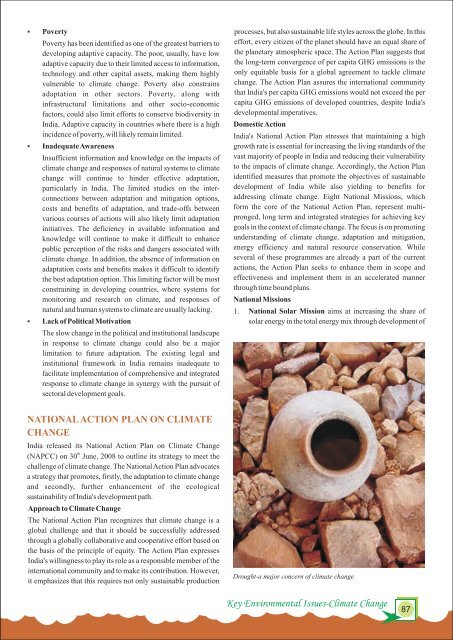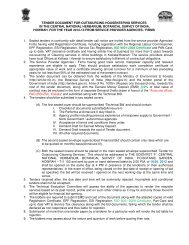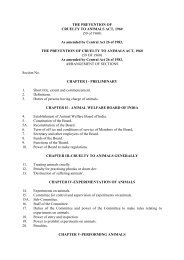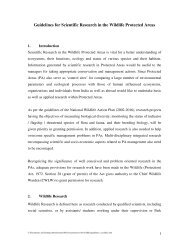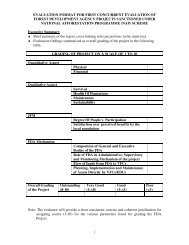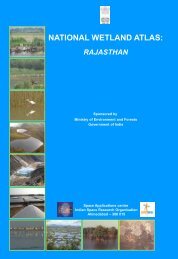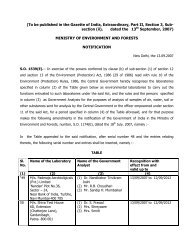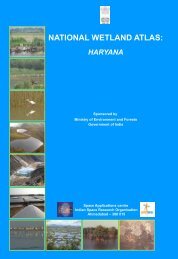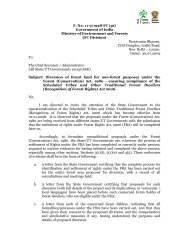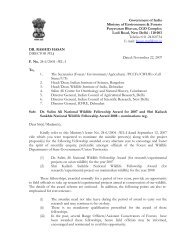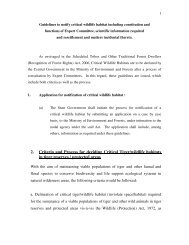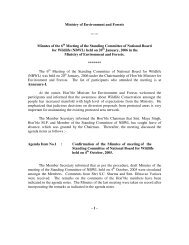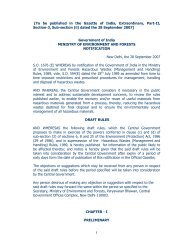lR;eso t;rs - Ministry of Environment and Forests
lR;eso t;rs - Ministry of Environment and Forests
lR;eso t;rs - Ministry of Environment and Forests
Create successful ePaper yourself
Turn your PDF publications into a flip-book with our unique Google optimized e-Paper software.
�Poverty<br />
Poverty has been identified as one <strong>of</strong> the greatest barrie<strong>rs</strong> to<br />
developing adaptive capacity. The poor, usually, have low<br />
adaptive capacity due to their limited access to information,<br />
technology <strong>and</strong> other capital assets, making them highly<br />
vulnerable to climate change. Poverty also constrains<br />
adaptation in other secto<strong>rs</strong>. Poverty, along with<br />
infrastructural limitations <strong>and</strong> other socio-economic<br />
facto<strong>rs</strong>, could also limit efforts to conserve biodive<strong>rs</strong>ity in<br />
India. Adaptive capacity in countries where there is a high<br />
incidence <strong>of</strong> poverty, will likely remain limited.<br />
�Inadequate<br />
Awareness<br />
Insufficient information <strong>and</strong> knowledge on the impacts <strong>of</strong><br />
climate change <strong>and</strong> responses <strong>of</strong> natural systems to climate<br />
change will continue to hinder effective adaptation,<br />
particularly in India. The limited studies on the interconnections<br />
between adaptation <strong>and</strong> mitigation options,<br />
costs <strong>and</strong> benefits <strong>of</strong> adaptation, <strong>and</strong> trade-<strong>of</strong>fs between<br />
various cou<strong>rs</strong>es <strong>of</strong> actions will also likely limit adaptation<br />
initiatives. The deficiency in available information <strong>and</strong><br />
knowledge will continue to make it difficult to enhance<br />
public perception <strong>of</strong> the risks <strong>and</strong> dange<strong>rs</strong> associated with<br />
climate change. In addition, the absence <strong>of</strong> information on<br />
adaptation costs <strong>and</strong> benefits makes it difficult to identify<br />
the best adaptation option. This limiting factor will be most<br />
constraining in developing countries, where systems for<br />
monitoring <strong>and</strong> research on climate, <strong>and</strong> responses <strong>of</strong><br />
natural <strong>and</strong> human systems to climate are usually lacking.<br />
�Lack<br />
<strong>of</strong> Political Motivation<br />
The slow change in the political <strong>and</strong> institutional l<strong>and</strong>scape<br />
in response to climate change could also be a major<br />
limitation to future adaptation. The existing legal <strong>and</strong><br />
institutional framework in India remains inadequate to<br />
facilitate implementation <strong>of</strong> comprehensive <strong>and</strong> integrated<br />
response to climate change in synergy with the pu<strong>rs</strong>uit <strong>of</strong><br />
sectoral development goals.<br />
NATIONAL ACTION PLAN ON CLIMATE<br />
CHANGE<br />
India released its National Action Plan on Climate Change<br />
th<br />
(NAPCC) on 30 June, 2008 to outline its strategy to meet the<br />
challenge <strong>of</strong> climate change. The National Action Plan advocates<br />
a strategy that promotes, fi<strong>rs</strong>tly, the adaptation to climate change<br />
<strong>and</strong> secondly, further enhancement <strong>of</strong> the ecological<br />
sustainability <strong>of</strong> India's development path.<br />
Approach to Climate Change<br />
The National Action Plan recognizes that climate change is a<br />
global challenge <strong>and</strong> that it should be successfully addressed<br />
through a globally collaborative <strong>and</strong> cooperative effort based on<br />
the basis <strong>of</strong> the principle <strong>of</strong> equity. The Action Plan expresses<br />
India's willingness to play its role as a responsible member <strong>of</strong> the<br />
international community <strong>and</strong> to make its contribution. However,<br />
it emphasizes that this requires not only sustainable production<br />
processes, but also sustainable life styles across the globe. In this<br />
effort, every citizen <strong>of</strong> the planet should have an equal share <strong>of</strong><br />
the planetary atmospheric space. The Action Plan suggests that<br />
the long-term convergence <strong>of</strong> per capita GHG emissions is the<br />
only equitable basis for a global agreement to tackle climate<br />
change. The Action Plan assures the international community<br />
that India's per capita GHG emissions would not exceed the per<br />
capita GHG emissions <strong>of</strong> developed countries, despite India's<br />
developmental imperatives.<br />
Domestic Action<br />
India's National Action Plan stresses that maintaining a high<br />
growth rate is essential for increasing the living st<strong>and</strong>ards <strong>of</strong> the<br />
vast majority <strong>of</strong> people in India <strong>and</strong> reducing their vulnerability<br />
to the impacts <strong>of</strong> climate change. Accordingly, the Action Plan<br />
identified measures that promote the objectives <strong>of</strong> sustainable<br />
development <strong>of</strong> India while also yielding to benefits for<br />
addressing climate change. Eight National Missions, which<br />
form the core <strong>of</strong> the National Action Plan, represent multipronged,<br />
long term <strong>and</strong> integrated strategies for achieving key<br />
goals in the context <strong>of</strong> climate change. The focus is on promoting<br />
unde<strong>rs</strong>t<strong>and</strong>ing <strong>of</strong> climate change, adaptation <strong>and</strong> mitigation,<br />
energy efficiency <strong>and</strong> natural r<strong>eso</strong>urce conservation. While<br />
several <strong>of</strong> these programmes are already a part <strong>of</strong> the current<br />
actions, the Action Plan seeks to enhance them in scope <strong>and</strong><br />
effectiveness <strong>and</strong> implement them in an accelerated manner<br />
through time bound plans.<br />
National Missions<br />
1. National Solar Mission aims at increasing the share <strong>of</strong><br />
solar energy in the total energy mix through development <strong>of</strong><br />
Drought-a major concern <strong>of</strong> climate change<br />
Key <strong>Environment</strong>al Issues-Climate Change<br />
87


